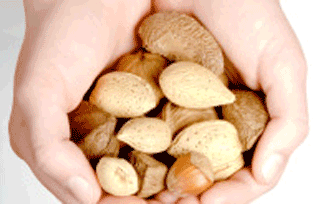Cuisine
Go Nuts
by LESLIE BECK
If you have Type 2 diabetes - i.e. your blood glucose (sugar) is higher than it should be - consider replacing some of the carbohydrates in your diet with a handful or two of nuts.
According to a new study, eating about half a cup of nuts each day can help people with diabetes lower their blood glucose and cholesterol levels.
These new findings add to mounting evidence that nuts confer important health benefits. Numerous studies have linked nuts with protection from heart attack, high blood pressure, high cholesterol, diabetes and even Alzheimer’s disease. Despite nuts’ high fat content, studies - including this one - haven’t linked them with weight gain.
Scientists suspect it’s actually the fat content that makes them so healthy: Nuts contain mainly unsaturated fat - polyunsaturated and monounsaturated fats - and only small amounts of cholesterol-raising saturated fat. They also deliver plant protein, some fibre and phytochemicals, which may also play a role.
The current study, published in the August issue of Diabetes Care, was led by David Jenkins, director of the Risk Factor Modification Centre at St. Michael's Hospital in Toronto. Researchers told 117 people with type 2 diabetes to replace some of the usual carbohydrates in their diet with nuts, a healthy muffin or a combination of the two.
One group was given roughly 2.5 ounces (475 calories worth) of unsalted mixed nuts, a second group received a low-sugar, whole-wheat muffin, and remaining participants followed a half nut/half muffin regimen.
The unsalted nut mixture included raw almonds, pistachios, walnuts, pecans, hazelnuts, peanuts, cashews and macadamias. The muffin had a similar protein content to the nuts from the addition of egg whites and skim-milk powder.
After three months, those who ate 2.5 ounces of nuts daily had better control of their blood sugar and lower LDL (bad) cholesterol levels than participants in the other two groups. The full-nut eaters saw their hemoglobin A1C (HbA1C) blood test result drop by 0.21 per cent, a reduction that’s estimated to reduce the risk of damage to blood vessels by 8 per cent. (Over time, too much glucose in the blood can damage many parts of the body, including blood vessels, which can lead to heart attack and stroke.)
HbA1C is a marker for how much sugar has been circulating in your bloodstream over the previous two- to three-month period. The test measures how much of your hemoglobin - a protein in red blood cells - is coated in sugar. A higher HbA1C result indicates poorer blood-sugar control.
People in this study were already taking diabetes medications and typically had good blood sugar control. Nuts provided a beneficial effect above what was achieved by medication.
The half-nut group saw their HbA1C decrease by 0.07 per cent while the healthy muffin group did not see a change.
LDL cholesterol levels also decreased in the full-nut group, even though they were taking cholesterol-lowering statin drugs and had a low LDL at the start of the study. (LDL cholesterol fell from 2.5 mmol/L to 2.3 mmol/L.) The other groups did not see similar improvements
These results speak to the importance of diet in the treatment of Type 2 diabetes, even when taking medication.
Nuts are high in calories and easy to overeat. To prevent weight gain, substitute nuts for an equal number of calories from refined (white) starchy foods (e.g. bread, cereal, rice, pasta), sweets and sugary drinks.
Look for raw or dry roasted nuts and buy them unsalted. Check the labels. If you choose oil-roasted nuts, you’ll consume extra fat. Salted nuts contain up to 250 milligrams of sodium in a one-ounce serving.
(If you don’t like nuts or you have a nut allergy, other good sources of monounsaturated fat include extra virgin olive oil and avocado.)
The following tips will help you add nuts to your daily diet.
•- Top your morning breakfast cereal with nuts.
•- Add chopped walnuts or pecans to pancake and waffle batters.
•- Add ground nuts to smoothies.
•- Snack on a handful of nuts mixed with dried apricots or cranberries.
•- Mix slivered almonds or pine nuts into chicken salad for extra crunch.
•- Toss a handful of peanuts or cashews into an Asian-style stir-fry.
•- Sauté leafy green vegetables with cashews or pine nuts.
•- Add toasted walnuts to whole-grain pasta tossed in extra virgin olive oil.
•- Add pecan or walnut halves to green and spinach salads.
•- Add nuts to side dishes - hazelnuts to brown rice, pine nuts to couscous, or almonds to green beans.
•- Add ground nuts to burger and meatloaf recipes.
Know your nuts
A sample of nut nutrients in a one-ounce (28 grams) serving:
24 almonds (160 calories)
riboflavin, vitamin E, magnesium
18 cashews (160 calories)
magnesium, copper, plant sterols
20 pecan halves (200 calories)
copper, manganese
157 pine nuts (190 calories)
magnesium, copper, manganese, plant sterols
49 pistachios (160 calories)
vitamin B6, copper, manganese
14 walnut halves (190 calories)
copper, manganese, ALA (an omega-3 fat)
The author is a Toronto-based dietitian at the Medcan Clinic.
[Courtesy: The Globe and Mail]
July 14, 2011Conversation about this article
1: I.J. Singh (New York, U.S.A.), July 14, 2011, 5:40 PM.
Promises to be both deliciously tasty as well as healthy. What could be better? Hope and pray it doesn't turn out too good to be true.





